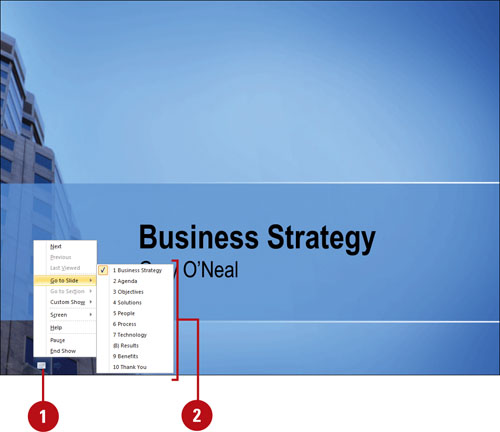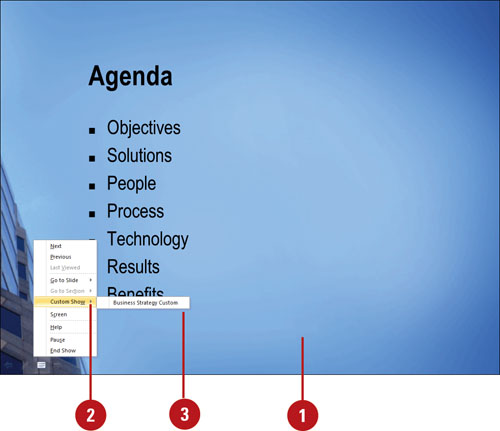Navigating a Slide Show
In
Slide Show view, you advance to the next slide by clicking the mouse
button, pressing the Spacebar, or pressing Enter. In addition to those
basic navigational techniques, PowerPoint provides keyboard shortcuts
that can take you to the beginning, the end, or any particular slide in
your presentation. You can also use the navigation commands on the
shortcut menu to access slides in custom slide shows and sections (New!). After a period of inactivity during a normal full-screen slide show, PowerPoint hides the pointer and Slide Show toolbar.
Go to a Specific Slide or Section
 In Slide Show view, move the mouse to display the Slide Show toolbar, and then click the Slide button.
In Slide Show view, move the mouse to display the Slide Show toolbar, and then click the Slide button.
Timesaver
Right-click a slide to display a shortcut menu.
 Point to Go to Slide or Go to Section, and then click the slide title or section to which you want to go.
Point to Go to Slide or Go to Section, and then click the slide title or section to which you want to go.

Did You Know?
You can turn your mouse into a laser pointer. In Slide Show view, hold down Ctrl, click the left mouse button, and the begin pointing (New!).
To change the laser pointer color, click the Slide Show tab, click the
Set Up Show button, click the Laser Pointer Color list arrow, select a
color, and then click OK (New!).
You can add speaker notes in Slide Show.
In Slide Show view, right-click a blank area on the slide, point to
Screen, click Speaker Notes, type your notes, and then click Close.
You can switch to another program in Slide Show.
In Slide Show view, right-click a blank area on the slide, point to
Screen, and then click Switch Programs. Use the taskbar to switch
between programs.
Use Slide Show View Navigation Shortcuts
 Refer to the adjacent table for information on Slide Show view navigation shortcuts.
Refer to the adjacent table for information on Slide Show view navigation shortcuts.
Slide Show View Shortcuts
| Action | Result |
|---|
| Mouse click | Moves to the next slide |
| Right-mouse click | Moves to the previous slide (only if the Shortcut Menu On Right-Click option is disabled) |
| Press Enter | Moves to the next slide |
| Press Home | Moves to the first slide in the show |
| Press End | Moves to the last slide in the show |
| Press Page Up | Moves to the previous slide |
| Press Page Down | Moves to the next slide |
| Enter a slide number and press Enter | Moves to the slide number you specified when you press Enter |
| Press B | Displays a black screen; press again to return |
| Press W | Displays a white screen; press again to return |
| Press Esc | Exits Slide Show view |
Go to a Custom Slide Show or Section
 In Slide Show view, right-click a slide.
In Slide Show view, right-click a slide.
 Point to Custom Show.
Point to Custom Show.
 Click the custom slide show that you want to go to.
Click the custom slide show that you want to go to.
